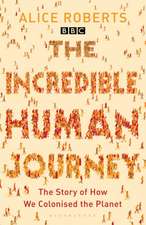Recent Advances in Palaeodemography: Data, Techniques, Patterns
Editat de Jean-Pierre Bocquet-Appelen Limba Engleză Hardback – 20 mar 2008
| Toate formatele și edițiile | Preț | Express |
|---|---|---|
| Paperback (1) | 641.03 lei 6-8 săpt. | |
| SPRINGER NETHERLANDS – 19 oct 2010 | 641.03 lei 6-8 săpt. | |
| Hardback (1) | 647.40 lei 6-8 săpt. | |
| SPRINGER NETHERLANDS – 20 mar 2008 | 647.40 lei 6-8 săpt. |
Preț: 647.40 lei
Preț vechi: 761.65 lei
-15% Nou
Puncte Express: 971
Preț estimativ în valută:
123.88€ • 127.80$ • 103.38£
123.88€ • 127.80$ • 103.38£
Carte tipărită la comandă
Livrare economică 26 martie-09 aprilie
Preluare comenzi: 021 569.72.76
Specificații
ISBN-13: 9781402064234
ISBN-10: 1402064233
Pagini: 294
Ilustrații: XIV, 294 p.
Dimensiuni: 155 x 235 x 19 mm
Greutate: 0.61 kg
Ediția:2008
Editura: SPRINGER NETHERLANDS
Colecția Springer
Locul publicării:Dordrecht, Netherlands
ISBN-10: 1402064233
Pagini: 294
Ilustrații: XIV, 294 p.
Dimensiuni: 155 x 235 x 19 mm
Greutate: 0.61 kg
Ediția:2008
Editura: SPRINGER NETHERLANDS
Colecția Springer
Locul publicării:Dordrecht, Netherlands
Public țintă
ResearchCuprins
From Genes to Numbers: Effective Population Sizes in Human Evolution.- Assessment of Land Surveys in Greece: Contributions and Limitations.- Estimation of An Age Distribution With Its Confidence Intervals Using An Iterative Bayesian Procedure and A Bootstrap Sampling Approach.- Model Life Tables for Pre-Industrial Populations: First Application in Palaeodemography.- The Halley Band for Paleodemographic Mortality Analysis.- Modeling Paleolithic Predator-Prey Dynamics and the Effects of Hunting Pressure on Prey ‘Choice’.- The Demography of Prehistoric Fishing/Hunting People: A Case Study of the Upper Columbia Area.- The Paleodemography of Central Portugal and the Mesolithic-Neolithic Transition.- The Libben Site: a Hunting, Fishing, and Gathering Village from the Eastern Late Woodlands of North America. Analysis and Implications for Palaeodemography and Human Origins.- Demographic and Health Changes During the Transition to Agriculture in North America.
Textul de pe ultima copertă
The written data used by demographers essentially cover the last five centuries. Since Homo Ergaster moved out of Africa around 1.8 million years ago and until the sub-contemporary periods, there is no data allowing us to reconstruct a demographic history that can be interpreted with the traditional tools of demography. If we want to be able to tackle demographic issues over a long evolutionary duration, trying to reconstitute our human demographic history and thinking out and testing macro-demographic theories, we need to draw on sources other than written data and on techniques other than those commonly used by demographers. This necessarily means using information of every kind, from archaeology, physical anthropology, paleontology, primatology or genetics, along with relevant models of interpretation.
This book has been developed from a core of papers selected for the paleodemographic session of the 25th World Population Congress (July 2005, Tours, France). It covers recent paleodemographic innovations, in terms of data, techniques and the detection of patterns making it possible to highlight hitherto unknown prehistoric demographic processes.
This book has been developed from a core of papers selected for the paleodemographic session of the 25th World Population Congress (July 2005, Tours, France). It covers recent paleodemographic innovations, in terms of data, techniques and the detection of patterns making it possible to highlight hitherto unknown prehistoric demographic processes.
Caracteristici
Covers recent paleodemographic innovations, in terms of data, techniques and the detection of patterns









